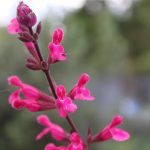Salvia involucrata ‘Mulberry Jam‘: is an upright slender perennial 1-1.2mH with small dark leaves and mulberry coloured flowers in spring and summer.

Salvia ‘Mulberry Jam’ is probably the smallest of the involucrata varieties.
Flowers: are semi tubular, a bright cerise or mulberry colour. A furry hood and small bottom lobes, all are the same colour, but a small white beeline is seen at the throat to guide bees and small birds into the flower. It is this small white beeline that can be seen when the plant is grown in a shady position.
Flowers appear in late spring, continuing over the summer season.
Calyces: are a crimson brown colour, ribbed with pointed lobes. Flowers are held in whorls of 6-8 flowers, most are open at the same time with the few remaining flowers opening later to extend the flowering period. Internodes are nicely spaced along the very dark stems.
All involucrata hybrids have an involucrote, some large, some only very small. An involucrote is a knob of bracts ( the same colour as the corollas) full of more flowers. Salvia ‘Mulberry Jam’ has a very small rounded knob. The small coloured bracts falloff as each whorl of flowers opens.
Leaves: are much smaller than most of the other varieties. Leaves are oval to ovate in shape, a dark green colour with a purplish colour beneath with very small crenations along the edges. The pink petiole and midrib are easily seen.
Salvia ‘Mulberry Jam’ is a slender upright perennial that forms a nice small clump for the middle of a bed in front of a taller hedge and low groundcovers in the foreground.
Plant with other white, vivid purples and blue perennials. The clear cerise coloured flowers also blend and contrast well with a pastel themed garden.
Grown in a sunny protected position, even in a dappled shaded area, it grows well over the summer season when well established. Tolerates the winter cold and light frosts, but appreciates protection from harsh winds.
At the end of summer when most of the flowering has finished, it’s time to clean out the clump. Cut stems down by half to encourage new basal growth. When new shoots are big enough, then cut the stems completely down. Feed and mulch well to keep the root area cool over the hot dry summer season, responding well to some summer watering.
Propagation: is usually by tip cuttings taken in spring and summer
Occasionally available
Back to Varieties


